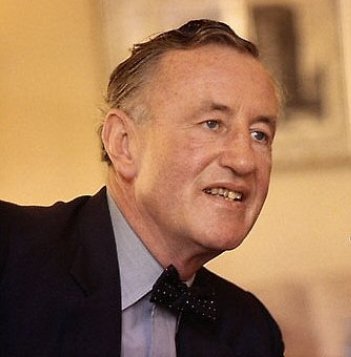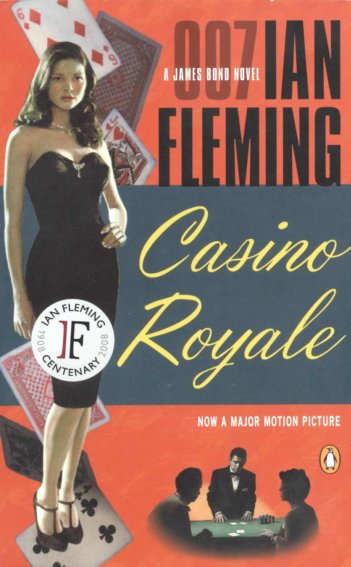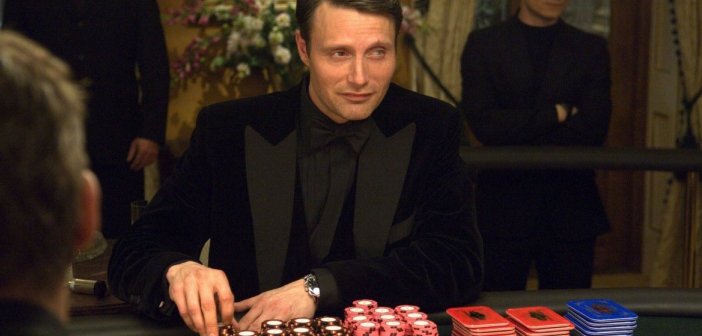Literature on Film | 15 | James Bond, Ian Fleming, Daniel Craig and Casino Royale
I continue to be taken aghast by the amount of people who admit to me that they’ve never seen a James Bond film. I accept that not all genres appeal to all people, but avoiding the entire Bond series for a lifetime is akin to managing to go your whole life without ever eating at McDonalds. The James Bond series is a pervasive cornerstone of capitalist society – a constant reminder of the supposed unlimited pleasures (however shallow) that await us if we pledge our allegiance to the free market with its buxom beauties, fine food and drink, fast cars and high-flying adventures and a distinct lack of the crushing blandness of Communism (or in more modern instalments “the world’s terrorists”). It’s the ultimate guilty pleasure.

I’m less surprised when people tell me that they haven’t read Ian Fleming’s James Bond novels. By modern standards, they’re dated – full of descriptive passages that would be considered excessive today, old-timey dialogue and generous helpings of nasty old conservatism. Nigel Farage may well have been mates with Ian Fleming, had the old bastard survived into the 21st Century. The series also just happens to be one of the best adventure series of all time. Fleming’s prose has a sharp, deadliness to it that’s rare in modern thrillers (reading Lee Child’s Jack Reacher series is often akin to watching an episode of ‘Walker Texas Ranger’). What’s most interesting about the books is that it gives us far more of an interesting portrait of the day-to-day mundanities of being a 00 agent, as well as the high-flying heroics we see all the time in the films. The books are decidedly toned-down as well. While in the movie, Pierce Brosnan may deploy heat-seeking rockets that fire from his Aston Martin while he skids across the ice as a laser from space tries to blow him up, the Bond of the books has adventures that are far more streamlined and nowhere near as ridiculous. While Fleming was something of a futurist, gadgets are mostly non-existent in the books. This may sound less appealing, but Fleming’s descriptive powers always made a simple car chase seem just as tense and exciting on the page as exploding pens were in the films.
With the character of James Bond, one of the great literary heroes (and anti-heroes) was created. Drawing on his own life experiences (with a healthy dose of his wildest fantasies), Fleming created a contradiction, a flawed ubermensch, a supposedly dull individual who could blend into the background while also being devilishly handsome, tough as nails, able to mete out cold-blooded Capitalist justice to any of the megalo-maniacal Communists who crossed his path and seemingly chemically irresistible to any woman with whom he came into contact. Agent 007 was born.

The literary Bond can be quite a different beast to his big screen brother. While Bond in the movies is known for his quick wit and his light hearted approach to danger, the Bond of the books was often a cold and nasty fellow who rarely indulged in humour. Similarly, while the cinematic Bond was a chauvinist at the best of times, the guy in the books is a dangerous monster of sexism. In Fleming’s opening gambit into the world of 007, ‘Casino Royale’ nary a chapter goes by without Bond either objectifying a woman’s body or complaining about how useless women are outside of domestic duties. “Women were for recreation,” Bond says in one of the passages of ‘Casino Royale’ “On a job, they got in the way and fogged things up with sex and hurt feelings and all the emotional baggage they carried around. One had to look out for them and take care of them.” Yeesh. What makes Bond compelling in the novels is his vulnerability. He constantly second-guesses himself, he’s never quite portrayed as being ‘the best in the business’ and we regularly see him in fear for his life.
Daniel Craig is the best James Bond ever. Make no mistake, Sean Connery was the right Scotsman for the job in 1962 when the fuse needed to be lit – creating an adventure character unseen in modern cinema at the time. Oddly enough, while legions of fans point to Connery as the ultimate all-time perfect casting, no one really felt that way at the time. Had there been an Internet when Connery was cast, he would have received just as much vitriol as Daniel Craig would 45-odd years later. The truth is, while Ian Fleming might have preferred suave gentlemen like Cary Grant or David Niven, the casting of Connery (a man who might more closely resemble a truck driver or a milkman than a movie star) gave cinemagoers a passport into this lavish, exotic world of transatlantic flights, sunshine and beautiful women. It wasn’t just a fantasy – they could relate to this guy. As so many have said before, men wanted to be him and women wanted to be with him. He wasn’t merely a heartthrob (as Grant certainly was) – he was a sex symbol. Before long, the logic of this finally occurred to the disgusted Fleming who added a Scottish heritage to Bond’s background in later books.

Many people trying to sound cool will use the argument that “Sean Connery is the only James Bond,” and this simply isn’t the case. The franchise doesn’t begin with Sean Connery and it doesn’t begin to end with him either. George Lazenby tried his best in what is arguably still the best film in the entire series, Roger Moore injected much-needed levity at a time when the franchise was on the ropes, the always-overlooked Timothy Dalton brought the character close again to the literary origins of Fleming’s books and Pierce Brosnan played a mean Greatest Hits tape. Each and every Bond brought something to the table. When comparing the actors to the character in the books, Dalton is still probably the best attempt at bringing that particular character to life. That said, Dalton’s character was far more likeable than Fleming’s Bond ever was (the beginnings of political correctness saw a softness in Bond’s attitude to the fairer sex) and at times, he seemed so loyal to the book’s character that he seemed unsuited to the suave style or the extravagant action scenes. Daniel Craig combines all the best elements of the cinematic Bond (with his puns, his style, his gadgets and his high-flying heroics) with the flawed vulnerability of the weary warrior of the books, a man who hated his job and hated himself, but soldiered on regardless. Despite so much criticism about his appearance (fair enough, Bond isn’t supposed to have blonde hair), Craig’s lovably bat-like features are oddly reminiscent of some of Fleming’s descriptions of the character, as having a face like “a taciturn mask, ironical, brutal, and cold.” When I hear the phrase ‘taciturn mask’, I don’t automatically think ‘Pierce Brosnan’. I certainly don’t think ‘Tom Hiddleston’ or ‘Aidan Turner’, but that’s an argument for another day.
Legend has it that while visiting a casino in neutral Portugal, Fleming noticed a group of Nazis at the Baccarat table and thought it would be a wonderful idea to try and beat them at the tables, thus inadvertently weakening Hitler’s funds. Sadly, they cleaned him out (the story was later hinted to have been embellished and that the people who cleaned Old Ian out were probably Portuguese entrepreneurs). Nevertheless, this served as the basis for ‘Casino Royale’.
The book version of ‘Royale’ opens the day of the all-important card game against the villainous LeChiffre. The film has an entire act-and-a-half before it reaches this juncture, involving some post-9/11 business about terrorists and LeChiffre (banker to ‘the world’s terrorists’ as the film cryptically puts it – a few films later it’s revealed that he was just working for SPECTRE the whole time) profiting from acts of terror by manipulating the stock market. He then loses millions when Bond foils a plot to blow up an aeroplane. In the book, it’s a little bit more straightforward – LeChiffre is an agent of SMERSH, a real-life Russian counter-intelligence agency short for ‘Shmiert Shpionam’ (“death to spies”; Fleming wisely made the decision to leave SMERSH out of the films, instead opting to use SPECTRE as a non-politically charged enemy). Le Chiffre’s investments in French brothels go south after they pass a pesky law that bans prostitution. Rather than face death at the hands of his overlords, Le Chiffre decides that the best course of action is to hold a high-stakes card game (as one does in such a situation) in the prestigious ‘Casino Royale’ so that he can win big at the tables and avoid having his head chopped off. Mi6 get wind of this and send their best card-player, who just so happens to be James Bond, to clean him out.

The characters of René Mathis and Vesper Lynd, Bond’s right-hand man and woman respectively, are introduced early in the novel. Mathis is a member of the Deuxieme Bureau with plenty of expository information about Le Chiffre and a glint in his eye – played to perfection by Giancarlo Giannini who plays some of Fleming’s misogynistic dialogue for laughs. In the book, Vesper is an Mi6 agent – in the film however, she is recast as a member of the British Treasury, who has been reluctantly swept into Bond’s mission to oversee the large amounts of taxpayers’ money with which he’s going to be gambling. One of the greatest advantages the film has over the novel is its characterisation of Vesper. Fleming’s Bond girls are seldom as interesting as their film counterparts – they’re all beautiful, they’re all fragile and none of them can wait to have sex with James Bond. They also continuously show Fleming at his most disgusting – Bond thinks to himself while dreaming of Vesper that sex with her will always be satisfying, because “the central privacy of her, would each time have the sweet tang of rape”. The film wisely updates Vesper, making her far more independent and far more resistant to Bond’s charms. It’s very easy to make the claim that Eva Green’s Vesper Lynd is the best love interest in a Bond film in 30 years. While the film’s (and the book’s) speedy love affair seems a little bit rushed, the chemistry of the two actors make it believable nonetheless. Unlike the book, where a light-switch seems to go off in Bond’s head when he realises he truly cares for Vesper and that she’s not the nuisance he assumed she’d be, the film creates quite a lovely portrait of two lost souls finding each other, only for tragedy to strike.
Like the film, Bond half-heartedly adopts a fake name when checking into the hotel, knowing full well that anyone who cares will know straight away who he actually is and why he’s there. Similarly, he narrowly avoids assassination on two occasions, although this is played very differently in the film version – he gets in a particularly clumsy fight to the death with an African warlord (one of the series’ most bloody fights), whereas in the book he has a gun pressed to his back while he’s playing.

One of the most notable differences between the book and film versions of ‘Royale’ is that in the book, Bond is playing ‘Baccarat’ – the kind of sophisticated affair you’d expect to see played in a room full of black ties and martinis. In the film however, they make the US Box Office-pleasing decision to make it game of Texas Hold ‘Em. It’s an odd choice to say the least – the glamour of the sequence is done a disservice by the fact that the characters are playing a game that is so often played in the back of greasy bowling alleys. Maybe if they ever remake Casino Royale they could have Bond and Le Chiffre battling over a round of ‘Call of Duty’ (it wouldn’t be the first time Bond has had a videogame duel with an enemy)? Baccarat is arguably an easier-to-understand game as well (speaking as a card-playing novice). Fleming mercifully describes the playing mechanic at the start of the chapter – whereas in the film we get awkward asides of Mathis describing what’s happening to a bemused Vesper Lynd. Despite the different games being played, both the film and the book share the same beats where the card game is concerned – after a few initial wins, Bond is completely cleaned out and is bailed out by C.I.A. agent Felix Leiter, who keeps him in the game, allowing him to win.
Later, like the film, Vesper is kidnapped by Le Chiffre in a desperate attempt to steal his money back (and save his life from the wrath of SMERSH/the world’s terrorists). What’s amusing here is that Bond chases after Le Chiffre’s men in his car – despite the fact that he’s been drinking martinis and sipping champagne all night (including the ‘Vesper Martini’ – a delicious concoction of Fleming’s own creation that would just as easily clean the inside of a jet engine). This really isn’t that different from the film version either. When he does catch up to the bad guys, both versions of Bond end up totalling their respective vehicles. Know the one that’s one too many.

Arguably the most famous sequence of the book and the film, is the infamous torture sequence where Le Chiffre attempts to extract information from Bond as to where he’s left the money. In both cases, Bond doesn’t relent, but we get some graphic depictions of a man’s nether regions being walloped almost to the point of extinction. The sequence in the film was shocking for audiences in 2006, but torture sequences like this were a common feature in the Fleming books (some of the most gripping scenes in any of the books showed Bond near-death in searing pain).
Much was made of how the film ‘Casino Royale’ was an origin story for 007, a sort of “Who he is and how he came to be”, at a time when rebooting a popular franchise was seen as an ingenious new approach to popular filmmaking, rather than a crass admittance by a big studio that they had run out of ideas. Interestingly enough, the novel plays as an origin of sorts. Bond’s initiation into the Double-Oh agency is explained (however briefly) and the book provides an interesting look at Bond’s examination of the world around him, what it is that keeps him motivated and why he never retires despite constantly staring death in the face. After Le Chiffre is defeated and Bond is recuperating, he contemplates leaving the service, recognising the futility of playing (as he calls it) ‘Red Indians’. Mathis leaves him with the chilling observation that “Now that you have seen a really evil man, you will know how evil they can be and you will go after them to destroy them in order to protect yourself and the people you love…” he then leaves by saying “Surround yourself with human beings, my dear James. They are easier to fight for then principles. But don’t let me down and become human yourself. We would lose such a wonderful machine.”
In the film and the book, Vesper Lynd is discovered to be a double agent in the final act. She has been working with SMERSH (or the shadowy organisation later revealed to be SPECTRE in the Craig films) in order to protect a man she once loved, now captured by the enemy. In the film, her demise comes after she drowns herself during a climactic action sequence. The book is far more horrible, as she overdoses on sleeping pills. In both cases, Bond is at once heartbroken and transformed into the ‘machine’ Mathis foretold. “He would attack the arm that held the whip and the gun. The business of espionage could be left to the white-collar boys. They could spy, and catch the spies. He would go after the threat behind the spies, the threat that made them spy.”
Ultimately, neither the film nor the book are better or worse than each other. The book is very low-key and is at times bogged down by Fleming’s uncomfortable attitudes to the opposite sex (a lot moreso than the other books). The film, perhaps due to its faithfulness to the books and the rest of the film series, occasionally experiences sluggish pacing and odd scripting (there are times during the first act of the film where you could be forgiven for wondering what’s going on). I happen to prefer the film as it’s a more well-rounded adventure than the book, which features Fleming getting warmed up, rather than giving us the full gamut of his abilities. The full series of novels by Fleming are well worth a read – despite certain elements which date them, they are nonetheless electrifying in a way seldom matched by modern thrillers or even the James Bond films. Nobody does it better.
Featured Image Credit

